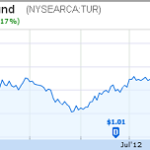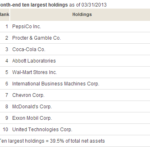AdvisorShares just launched a new fund it calls the AdvisorShares Global Alpha & Beta ETF (RRGR). An actively-managed fund, AdvisorShares will run the portfolio with a goal to beat a benchmark comprised of a weighting of stocks and bonds.
The fund will compete with a benchmark similar to a 60-40 mix of the S&P 500 index and the Aggregate Bond Index. The goal is to reduce volatility while increasing returns, moving funds in between equities and fixed-income positions in the ETF.
Investment Selection
The Global Alpha & Beta ETF (RRGR) will seek first to determine an appropriate balance of stocks and bonds in the portfolio. The fund will make asset allocation decisions based on two driving factors: the 200 day moving average for the S&P 500 index as well as the bond yield curve. The fund manager looks to the S&P 500 value relative to its historic moving average and bond curve inversion as buy and sell signals.
From there, the fund will also seek to outperform with alpha in sector rotation by choosing to overweight or underweight one or several of the 10 different sectors represented in the S&P500 index. The fund also reserves the right to build individual positions based on fundamental factors to find undervalued businesses.

Fund management sees no problem in tilting the scales to one side of the stock or bond seesaw. As of July 10, the fund held 88% of its assets in equities, with only 12% in cash or debts securities that will mature in less than one year.
A True Active and Macro Fund
The Global Alpha & Beta ETF is a true global and macro fund, following several new funds in what is one of the ETF space’s hottest trends: active tactical management. Funds that place trades based on a 200-day moving average became more popular following the 2009 financial crisis. Investors who buy and sell based on the 200-day moving average would have sold stocks in 2008 and moved back into equities in 2009, just as the market bottomed.
AdvisorShares will have to prove the strategy can be successful with its new fund, which is certainly on the more expensive end of actively-managed funds. The ETF comes with a net annual expense charge of 1.4% per year – a hefty price to pay for an ETF. Investors could replicate the Global Alpha & Beta ETF on their own, duplicating the fund’s basic asset allocation model with the SPDR S&P 500 ETF (SPY) and Vanguard Total Bond Market ETF (BND), which charge fees of .09% and .10%, respectively (or see more exotic bond ETF choices with higher yields).
The MSCI Emerging Markets Index ETF (EEM), which charges .67% per year (or see more focused emerging markets ETFs), could be substituted for the emerging market equity positions that the Alpha & Beta ETF will hold.
All in all, the 200-day moving average strategy does seem to be a winner. Historically, someone who swaps stocks and bonds depending on the relative value of the major indexes to the 200-day moving average would have done quite well. But there’s no way to say whether the strategy will hold up going forward. Those willing to take the shot, however, would do well to follow this ETF as it builds up a record.
Disclosure: No positions in any of the ETFs discussed here.











{ 0 comments… add one now }